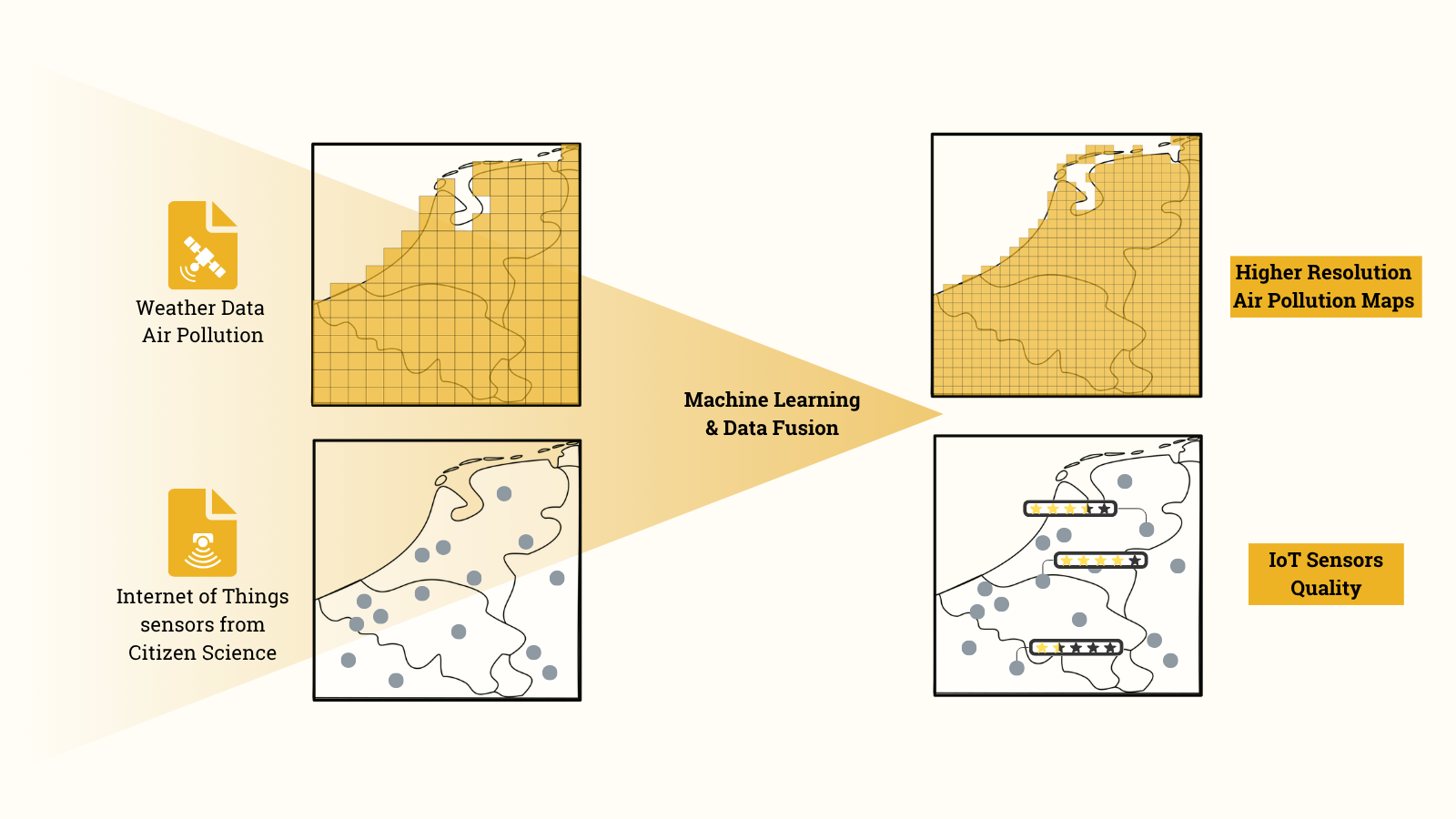Pilot 3: Air Quality
Urban air quality monitoring with low-cost IoT sensors and citizen communities
Poor urban air quality causes serious health issues across Europe. Accurate and localized monitoring is the first step towards better informed decisions about health in cities and urban environments. AD4GD has explored the potential benefits of IoT data for enhancing local air quality monitoring, increasing the density of the observation networks and the resolution of the air pollution insights. Notably, some of these sensors are operated and maintained by citizens, thereby fostering community involvement and promoting local engagement.
Berlin is considered to be a “green city”. 30% of its total area is covered by forests and other green spaces. 6% is covered by water. The latter comprises not only the Spree-Havel river and lake system, but also more than 300 small lakes, of less than 50 hectares in size each, that are distributed throughout its urban fabric.
Berlin’s ecosystems face challenges related to the city’s rapid densification and climate change. In particular, many of those small lakes suffer from the increased ocurrence of temperature and rain extremes.
Urban lakes are crucial sources of freshwater for humans and can have tremendous ecological benefits. On one hand, they are home to a variety of aquatic and terrestrial plants and animals, making them important biodiversity hotspots. They are also climatic refuges, helping to help cool down cities by reducing the heat island effect, and provide spaces for leisure, which support citizens physical and mental health.








The air we breathe is eventually polluted with particulate matter, ozone, nitrogen dioxide, sulfur dioxide and carbon monoxide which, acording to the WHO, present robust evidence of risks for public health. These pollutants originate from natural sources and human activity, including combustion, transportation, cooking, heating, waste dump sites, industrial activities, and agriculture.
Breathing polluted air may contribute to the development of cardiovascular and respiratory diseases such as ischemic heart disease, chronic obstructive pulmonary disease, pneumonia or asthma, among others.
Advocating for a proper air quality is crucial for the Green Deal and the Sustainable Development Goals, specifically target 3.9 and target 11.6. Compliance with climate change mitigation policies could reduce PM2.5 emissions by 17% and prevent more than 74,000 premature deaths annually in Europe.
Air quality monitoring networks are usually sparse and unable to provide high resolution insights. This is especially pronounced in densely populated areas, where strong gradients exist, and a wide variety of sources contribute to the overall pollution levels.
Low-cost sensors present significant opportunities for air quality monitoring. They enable the creation of dense measurement networks that provide real-time, localized data on air pollution levels, facilitating the identification of pollution hotspots and trends, the development of early warning systems and informing mitigation strategies.
However, the accuracy and reliability of low-cost sensors is usually a challenge. These sensors are generally less durable and maintained by non-professionals, resulting in concerns about the consistency and quality of the measurements.

The AD4GD Approach
Evaluating the usability of citizen science observations with IoT sensors
AD4GD has developed a rigorous approach based on machine learning for evaluating the practical usability of citizen science observations of air quality based on IoT sensors. The focus has been set on data from the Sensor.Community network, but the same approach has been applied to different regions in Europe that represent different air quality regimes and unique regional characteristics such as orography, air pollution sources and weather patterns. This activity has been a key source of insights and examples for the project’s Data Trustworthiness Framework. The machine learning approach, developed by ECMWF, was complemented by the collocation functionalities of the data ingestion system of Aston University, which allowed the comparison of multiple sensor types within the same spatial bounding box, in order to assess consistency within and between sensor types. The open-source tools developed for data harmonisation and comparison can enrich the practice of citizen scientists by generating assessments of instrument and measurement quality for open analysis and discussion.
Simplified data flow schema for the water pilot. Author: Diego de la Vega (CREAF).
Trustworthiness assessment and harmonisation
The developed data processing and harmonisation pipeline transform raw, unevenly distributed time series from low-cost IoT air quality sensors into consistent, high-resolution spatiotemporal datasets. This pipeline is essential to ensure that the observational data are trustworthy, specifically usable, and compatible with downstream workflows such as model validation or exposure mapping, and to facilitate the integration into futher applications, such as the ECMWF’s Cross Data Store.
The pipeline consists of two tightly coupled stages. Firstly, a trustworthiness assessment and correction, where unreliable or biased data are identified and corrected, and secondly, spatial harmonisation, where the cleaned time series are interpolated into gridded 3D data cubes using kriging techniques. Both stages are built to be modular and scalable, capable of handling large volumes of heterogeneous observations across multiple years and sensor network configurations. Find all details in Deliverable 6.2.
Collocation and quality-checking of low-cost sensors
The low-cost sensors automated ingestion tool developed in AD4GD enabled ingestion and harmonisation data from sensor types not available through other aggregation platforms, like mobile personal devices, and has also facilitated the easy intercomparison of data from experimentally collocated sensors, to evaluate quality and consistency. The semantic enrichment of the data improves the opportunity to identify which data is genuinely comparable and highlight the need for additional correction steps before data are combined. An example notebook can be explored in GitHub.
ECMWF's Cross Data Store
All processed data products are made accessible via ECMWF’s Cross Data Store (XDS). The XDS is a federated data access infrastructure that enables users to discover, query, and retrieve environmental datasets from multiple thematic sources through a unified interface.
Both the IoT-only and IoT+CAMS gridded data cubes, along with accompanying metadata, are published in standardized formats and registered within the XDS. This ensures compliance with FAIR principles and supports integration with other Copernicus data products and services, such as those provided by CAMS and C3S.
Through the XDS, researchers, public agencies, and application developers can seamlessly access harmonised air quality data in combination with complementary geospatial datasets, facilitating cross-domain environmental analysis and decision support.
Leading partner:

Useful links:
References:
> Bastin, L., Kriukov, V., Lush, V., Serral, I., Hodson, T., Borger, C., & Zamzow, M. (2025). AD4GD D6.2. Pilot Technical Implementation Planning, Implementation and Assessment Report. Zenodo.
Do you want to learn more?
Enhancing Air Quality Monitoring with IoT and Low-Cost Sensors
Many European cities have air quality below WHO recommendations. IoT technology and low-cost sensors driven by citizen science offer a cost-effective solution to monitor air pollution.
Unlocking the Potential of Unconventional Data in Environmental Observations with Ulrike Falk from ECMWF
How is ECMWF participating in the integration of environmental satellite data with IoT and socioeconomic information whithin the context of the AD4GD project?
AD4GD pilots begin their journey with a workshop in Bonn
During the workshop, organized by Fraunhofer FIT, the most important features to be included in the pilots solutions were defined.
Stay tuned with us!
We share all our news & events in our newsletter





